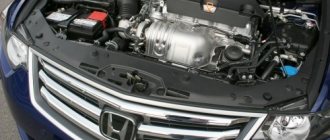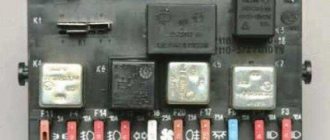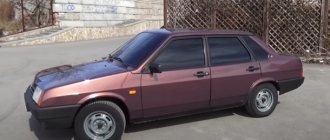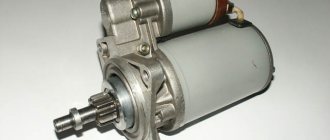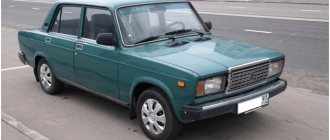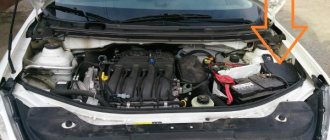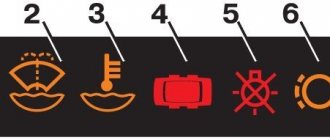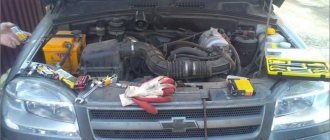I have a question, has anyone encountered this problem? The temperature outside was about -20 degrees. There was not enough gasoline in the tank, auto heating was turned on. I had 3 days off. The auto-heating was running out of gasoline. The morning after the weekend the car would not start. The first thing I did was fill in 10 liters of gasoline. Now the temperature is about 0 degrees, the car will not start. The starter turns. There's even a strange grinding noise and it won't start. What could be the problem?
lexzas
, Unscrew the spark plugs and see how they are.
If you are flooded here. https://www.primera-club.ru/f/dvigate. blemy-v-moroz/
Read this topic VERY
Hello everyone! I have a Prima12 Japanese QR20 No spark. What could it be?
MARKIANOV
, Some kind of bug has come up.
Battery problems
If the Nissan Primera does not start, it is recommended that you first pay attention to the battery. When it is discharged, starting the power unit is impossible. This is due to the fact that when the starter motor is connected, the on-board voltage will drop below the permissible level. As a result, instead of successfully starting the engine, the car owner will hear the crackling sound of the retractor relay coming from the engine compartment of the Nissan Primera P12.
Most often, problems with a used or discharged battery occur in winter. This is due to the fact that motor oil thickens in cold weather. This makes it harder for the starter to crank the engine, so it consumes increased starting current. The battery has poorer performance in the cold season than in the summer heat. Its starting current and energy output are reduced. The superposition of these factors on top of each other leads to complications in starting the engine and even the impossibility of starting the engine.
To solve the problem with a discharged battery, it is recommended to use one of the following methods:
- start the power plant “by lighting” from another vehicle;
- recharge the battery with a nominal or increased current using a charger;
- start the power unit using ROM.
If the battery runs out once, you can solve the problem by recharging the battery. If the battery discharges constantly and quickly, then it needs to be diagnosed. Based on its results, a decision is made on the advisability of repairing or replacing the power source. Experienced car owners recommend that if the battery has a significant service life, replace it with a new one without trying to restore it.
If the diagnostics show that the battery is fully operational, but the problem with its rapid discharge still exists, you need to check the on-board network. During inspection, a short circuit or significant leakage current is usually detected. If they are identified, you should promptly begin troubleshooting. Otherwise, there is a high risk of the Nissan Primera catching fire.
The presence of mechanical damage to the battery case leads to loss of electrolyte and a decrease in the starting current output. To monitor the condition of the battery, it is important to visually inspect the battery. If through cracks and other damage are detected, it is recommended to install a new power source to replace the old one.
Video “Self-diagnosis Nissan Primera P12”
Check out the process of self-diagnosis of a car at home (video author - Anton AUTO).
The Nissan Primera is a reliable car, but despite this, the risk of being unable to start the engine still exists. The reasons for this problem can be very different.
Some problems can be easily fixed with your own hands, but solving some problems may require a diagnostic scanner or other special tools.
ATTENTION! A completely simple way to reduce fuel consumption has been found! Don't believe me? An auto mechanic with 15 years of experience also didn’t believe it until he tried it. And now he saves 35,000 rubles a year on gasoline! Read more"
Nissan Expert stalled and won't start
After this, you need to turn the key and keep the end of the wire near the metal. There must be a good spark. Problem with the ignition switch. It happens that some terminal falls off in the lock itself. Especially on older cars.
Naturally, you need to know where to put it again. In addition, fuses may blow.
Therefore, it is always worth having a set of spare ones in your car. It is inexpensive, does not take up space, and a blown fuse can not only be the reason why, for example, turns do not work. It’s worse when the internal combustion engine does not start for this reason. Other possible malfunctions Problems with the starter retractor relay. The most common problem here is burnt nickels can only be seen when the Nissan Expert won’t start and the device is disassembled.
In addition, contacts may become unsoldered from them. In this case, when you turn the ignition key, only a quiet click of the starter relay will be heard, and the retractor will be silent. If it is working, then the Nissan Expert will not start; there will be a clear metallic click. It is unlikely that it will be possible to repair it on the road. Although the repair is inexpensive and relatively simple. The starter has failed.
Fuel injection system failures
To ensure fuel injection and determine the optimal portion, the electronic engine control unit receives information from several sensors in real time. When one of them fails, problems begin. Nissan Primera has the ability to perform self-diagnosis. This requires:
- Insert the ignition key.
- Turn the key to the “On” position and hold for three seconds.
- Over the next five seconds, depress the gas pedal 5 times.
- Wait seven seconds.
- Squeeze the gas all the way. Hold your leg in this position for 10 seconds.
- Wait for the “MI” indicator to appear on the instrument panel.
- Take your foot off the gas pedal.
- Look at "Check engine". It will flash. You need to count short and long flashes. They encrypt the error code. If the indicator blinks 10 times, then no problems are detected.
A simpler way is computer diagnostics. It requires a tester. It connects to the connector located under the steering wheel.
Nissan Primera P12 2004 1.6 does not start no spark on coils
Who is he taking the car to? Again to the mechanics because I recently overhauled the head with the replacement of the timing chain hydraulic tensioner or to an electrician to check the chain! Or should I already order the brains? Additionally, check whether the high voltage wires are securely fastened and whether the insulation is damaged. Modern ignition systems, due to high ignition voltages, react more sensitively to jumping sparks and creeping currents.
Is there damage to the 74 kW ignition distributor cap?
Pay special attention to the inside. Are all ignition system components clean and dry? Wet dirt promotes voltage breakdowns.
During the following measurements, please note that measuring and control devices should be connected and disconnected only when the ignition is turned off. If the engine is repeatedly cranked with the starter without starting to check and take measurements, then you must first disconnect the wire connectors on the injection valves.
no spark
Is the voltage supply to the ignition system OK? Along with a complete failure of the ignition system due to lack of voltage, its insufficient supply can also cause significant disturbances in the operation of the system! Connect the measuring device to the disconnected connector between pin 1, terminal 15 and pin 3 ground. The device should show a minimum of 11.5 V.
If it does not show the presence of voltage at all or is too low, then the defect lies in the wire to the ignition switch. 92 kW engine: Four-cylinder kW engine: These are connector slots 2 and 3.
There, too, the device should show at least 11.5 V.
Does not start. The starter turns. QR20
I have a question, has anyone encountered this problem? The temperature outside was about -20 degrees. There was not enough gasoline in the tank, auto heating was turned on. I had 3 days off. The auto-heating was running out of gasoline. The morning after the weekend the car would not start. The first thing I did was fill in 10 liters of gasoline. Now the temperature is about 0 degrees, the car will not start. The starter turns. There's even a strange grinding noise and it won't start. What could be the problem?
Hello everyone! I have a Prima12 Japanese QR20 No spark. What could it be?
MARKIANOV
, Some kind of bug has come up.
Nissan Primera won't start in cold weather
But who notices this? Everything is attributed to the cold, starter, battery, engine, and then they pulled it into a warm box and everything started working... Yes, until the next cooling.
There will be many letters and few pictures. For those who don’t like to read, I’m sorry... Every year with the onset of cold weather, history repeats itself. Dozens of posts appear about cars that refuse to start in the cold, and after the first unsuccessful attempt, it is almost impossible to revive the car.
These records have gained notoriety for this car brand.
Nissan Primera won't start
Is it really that bad? Let's try to figure it out: Firstly, starting the engine in cold weather, and even in quite a bit of frost, predetermines increased requirements for all vehicle systems. We will not consider cars in perfect condition in terms of the engine, lubrication, fuel, electronic and cooling systems.
As a rule, such cars do not have starting problems. This is affected by the owner’s attitude, timely maintenance and preparation for the winter season.
The Nissan example won't start in the cold - excellent, we're just proud of it and move on to the group that - well, it's always a problem.
Nissan Primera P12 QG16. Doesn't start when cold.
Most often, oddly enough, this group includes cars made in Japan, Prouli, Yapiks with a 2 engine. These conclusions are based on the results of forums and communities on this model and mass requests with the question - it won’t start in the cold.
Moreover, if for some people the frosts are critical, then for others problems are already beginning. Naturally, they happen, and in European versions of pre-Restay, Nissan Primera quite often does not start in cold weather, but less often. Personally, when I replaced the spark plugs with new ones, nothing happened.
Nissan example won't start: reasons, how to fix it
The story goes like this: we were driving, lost traction, turned off the car and never started again. Neither the starter nor the pusher... Everything died. Fuel is supplied, there is a spark. When we brought it in for service, the pressure in the pump is excellent, there is even compression in all cylinders. They played on the service for two days and this and that. We changed the roller on the distributor and also left from there on the cable. Then we completely removed the distributor ourselves, everything seems to be fine...
And then, purely by chance, I forgot to turn off the ignition and turned the distributor and a spark jumped (it turned out it was breaking through the ignition coil)…
Hello! I have a Nissan Primera P12. The problem is that it won't start when the engine is cold. Thank you in advance for your cooperation! (Gulnar)
Hello, Gulnar. The problem of the inability to start the engine when cold is relevant for many Nissan drivers. We will provide some recommendations for resolving this issue, we hope they will help you.
Nissan Primera won't start
I drove it around, turned it off and started it 2 times while stopping. The starter won't turn over again. There was a service nearby. The electrician guy came up, felt the wiring with the light bulb, said something about the starter, current was flowing to it.
We stood there again, everything shook, it wouldn’t start. I turned the key again and it started. The next day I drove a lot, turned it off and started it, everything was ok.
Experienced car owners recommend that if the battery has a significant service life, replace it with a new one without trying to restore it. If the diagnostics show that the battery is fully operational, but the problem with its rapid discharge still exists, you need to check the on-board network.
During inspection, a short circuit or significant leakage current is usually detected. If they are identified, you should promptly begin troubleshooting.
Otherwise, there is a high risk of the Nissan Primera catching fire.
The presence of mechanical damage to the battery case leads to loss of electrolyte and a decrease in the starting current output. To monitor the condition of the battery, it is important to visually inspect the battery. If through cracks and other damage are detected, it is recommended to install a new power source to replace the old one.
Security system and its effect on starting the car The Nissan Primera has a standard security system in the form of an immobilizer. The car owner has the opportunity to further protect the car by installing a purchased car alarm. If it is not installed correctly or one or more components malfunction, a situation may arise when the engine does not start.
Problems that arise with the security system are usually of a physical or software nature. The first involves sticking or breaking the contacts of a mechanical relay or other automation elements. For diagnostic purposes, it is recommended to completely remove the installed security system. After this, carry out a test start of the engine. If it was successful, then the fault should be looked for among the car alarm units. nissan primera starter does not turn
won't start, starter won't turn
It is important to check each module, as well as the correct connection. A typical malfunction of the Nissan Primera, which affects the starter does not turn the engine, is souring of the antenna and immobilizer contacts. To fix the problem, car owners are advised to remove the chip from the module and fill everything with contact grease. If there are oxides on them, it is recommended to pre-clean them.
Problems in the ignition system Problems in the ignition system are mainly related to the spark plugs. They work in harsh conditions and are often damaged. If the electrodes are destroyed, it is impossible to create a normal spark.
Therefore, the engine does not start, even though the starter turns perfectly. To diagnose a malfunction, it is recommended to unscrew the spark plugs and inspect them.
Malfunctions of the engine power supply system
The most common problem that prevents the engine from starting among new car owners is running out of gasoline in the fuel tank. The reason for this is that the indicator on the control panel often gives false information. The solution to the problem is to refuel the Nissan Primera. There are other troubles in the motor power system. A brief overview of them is presented in the table below.
Table - Manifestation of fuel system malfunctions
| Cause of malfunction | Manifestation |
| Filled with the wrong fuel | Appears immediately after refueling |
| Injector nozzles clogged | The difficulty of starting the power unit occurs gradually |
| Damage to the fuel pump | Nissan Primera stalls and will no longer start, despite the fact that the starter rotates the crankshaft normally |
Why won't Almera start?
- The starter has failed;
- there are malfunctions in the fuel system;
- no spark;
- the crankshaft position sensor is faulty;
- The mass air flow sensor (MAF) is not functioning or is not working properly;
Problem number one: broken starter. How to determine that it is the one that is faulty? If you open the hood and listen, then when you try to start the car, the Nissan Almera stater will make sounds characteristic of a running electric motor. If they are not there, then obviously the problem is somehow related to the starter. Stopping the starter can be caused by an alarm. Problems with it should only be resolved under the guidance of an auto electrician.
Problems with the fuel system can be of several types:
- The fuel pump has failed;
- fuel pipes or filter are clogged;
- injectors are not working properly;
- Condensation has formed in the tank.
Most often, it is the fuel pump that fails, since it works almost continuously, especially if the car is used daily. The second most common problem is clogged fuel pipes or filter, and this problem occurs due to low-quality fuel. In most cases, the injectors operate normally, but their failure is also possible due to bad gasoline. The presence of condensation in the tank will prevent the fuel from burning completely.
The lack of a spark can be due to two reasons at once. The most obvious is problems with the spark plugs, that is, large soot, an unnatural gap, damaged insulation or excess fuel. Diagnosing them is very simple: just unscrew the spark plug and conduct an external inspection. If there is soot on the tip, the gap does not correspond to the factory value, a crack is noticeable in the ceramic insulation, or the tip is wet, then the spark plug must be replaced. Also, to determine the “flooding”, you should inspect the spark plug channels. If fuel is visible at their bottom, you should inspect the mass air flow sensor and injectors.
Soot on Almera spark plugs is one of the problems due to which engine starting and operation become unstable
Another possible problem is faulty coils. Checking them is also very simple: just screw in a working, previously tested spark plug and try to start the Almera engine. If there is no spark, then the coils require attention. Important: before carrying out any mechanical work on electrical appliances, you should turn off the power to the car, that is, remove the terminals from the battery.
Diagnosing problems with the crankshaft position sensor is very simple: when you try to start, the Check Engine light will light up on the dashboard. This theory can only be confirmed or refuted at a service station, where there should be a special device for testing DPKV. If the car starts and stalls, the speed fluctuates or the power drops when the load increases, you should pay attention to the sensor.
The mass air flow sensor, or MAF, is a device that measures the air consumption of the engine. Problems with it can cause increased fuel consumption, detonation, or the inability to start the engine. Why? If the sensor is faulty, the system thinks that the car is consuming a lot of air. In proportion to it, the injectors increase the volume of supplied fuel. Accordingly, fuel consumption increases, detonation may occur, or the spark plugs are simply flooded.
How to start a Nissan Almera in cold weather - DIY car repair
› Almera
Nissan Almera has gone through several generations during its production. Of course, different power plants were used. Next, we will dwell in detail on modifications of engines of all generations of Almera.
GA14DE, GA16DE, QG15DE, QG18DE, QG16DE, K4M
Nissan Almera N15 engines
The first generation Nissan Almera was equipped with two types of gasoline engines:
On the second modification it was possible to choose a manual or automatic transmission. The GA14DE engine was combined with a manual transmission only.
GA14DE
The GA14DE is rusty in places, but the engine is over 20 years old
The GA14DE 1.4 liter power plant was produced with a cast iron cylinder block and an aluminum valve cover. The use of dual camshafts (D-DOHC) and a power supply system with multipoint injection were envisaged. The engine resource is approximately four hundred thousand kilometers.
Technical characteristics of the GA14DE engine:
- exact volume (cubic cm) – 1392;
- power (hp) – 87;
- torque (N/m) – 116;
- compression ratio – 9.5;
- number of cylinders – 4;
- valves per cylinder – 4;
- timing gear drive – chain;
- fuel - gasoline.
3-door hatchback before update
Let's look at gasoline consumption per hundred kilometers using the example of a Nissan Almera N15 with a five-speed manual transmission:
- 7 l – mixed cycle of operation;
- 9.2 l – movement within city limits;
- 5.8 l – driving on the highway.
Weaknesses and advantages of the 1.4 Almera N15 engine
The Nissan Almera N15 engine of the GA14DE modification has the following advantages:
- The service life of the chain drive of the gas distribution mechanism is more than 250 thousand kilometers.
- Low fuel consumption.
- Good characteristics.
- Long engine life, plus there is the possibility of major repairs.
THIS IS INTERESTING: Replacing valves on a VAZ 2110 8 valves
The disadvantages include:
- Over time, the engine begins to stall periodically. The disadvantage manifests itself due to clogging of filters, meshes, jets and other channels.
- Floating speeds are recorded due to failure of the idle air valve sensor or mass air flow.
- Excessive consumption of engine oil on high mileage units. The problem is associated with stuck oil rings, faulty caps and leaky gaskets.
GA16DE
The GA16DE engine used on the Nissan Almera N15 has the following technical characteristics:
- cylinder block material – cast iron;
- power (hp) – 90-115;
- exact volume (cubic cm) – 1597;
- torque (N/m) – 123-150;
- compression ratio – 9.5;
- injection - carburetor or injection;
- number of cylinders – 4;
- number of valves per cylinder – 2 or 4;
- timing drive – chain;
- fuel - gasoline;
- resource (thousand km) – more than 300.
Specific performance indicators for power, torque, injection and the number of valves per cylinder depend on the modification of the GA16 engine.
Fuel consumption
Almera N15 with 5-speed manual transmission - average gasoline consumption is 7.3, and within a populated area and on the highway - 9.3 and 6.1 l/100 km.
Nissan Almera N15 with 4-automatic transmission consumes gasoline:
- 8.2 l – in a mixed cycle;
- 11 l – in the city;
- 6.7 l - outside the city.
5-door hatchback after update
Advantages and disadvantages
The main advantages of the GA16DE engine when used on the Almera N15:
- reliability;
- unpretentious operation at subzero temperatures;
- availability of spare parts and consumables;
- Finding a contract engine is easy.
The disadvantages of the power plant include:
- Irrational ratio of volume and power.
- Increased fuel consumption during city driving.
- Periodic failure of the DMVR and IAC, which is accompanied by floating speed.
- After a run of 200 thousand km, there is an increase in engine oil consumption and timing chain stretching.
- Wear of the crankcase ventilation gasket leads to oil leakage.
Engines Nissan Almera N16
The second generation Nissan Almera (N16) used a one and a half liter QG15DE engine with a manual transmission, as well as a 1.8 liter QG18DE engine in combination with a manual transmission or automatic transmission.
Engine QG15DE
QG15DE was produced from 2000 to 2006 and had the following technical characteristics:
- exact volume (cubic cm) – 1498;
- cylinder block - made of cast iron;
- power (hp) – 90-109;
- torque (N/m) – 128-143 (like the previous indicator depends on the modification of the motor);
- compression ratio – 9.9;
- food – injector;
- number of cylinders – 4;
- number of valves per cylinder – 4;
- timing drive – chain;
- resource (thousand km) – more than 250.
QG15DE at implement belt side
Fuel consumption per 100 km of Nissan Almera N16 with QG15DE engine and five-speed manual transmission:
- 6.6 l – medium;
- 8.6 l – in the city;
- 5.5 l - outside the city.
Weaknesses of the QG15DE motor
When operating the QG15DE engine on a second generation Almere, you may encounter the following disadvantages:
- Timing chain stretches; breakage occurs less often.
- Clogged throttle valve or fuel pump mesh, which leads to difficulties starting the power unit.
- Periodically, the ignition coils fail and the engine begins to stall.
- Loosening the tension of the generator drive belt. The disadvantage is manifested by a voltage drop when the headlights are turned on, as well as belt whistling.
- Malfunctions of the injection system.
- Low catalyst life.
- The engine cooling circuit uses low-quality elements that fail over time.
QG15DE exhaust side
QG18DE
The QG18DE engine, produced from 1998 to 2006, is characterized by the following indicators:
- cylinder block material – cast iron;
- power (hp) – 115-128;
- torque (N/m) – 158-175;
- exact volume (cubic cm) – 1769;
- compression ratio – 9.5;
- food – injector;
- number of cylinders – 4;
- number of valves per cylinder – 4;
- timing drive – chain;
- the fuel used is AI-95 gasoline;
- resource (thousand km) – in the range from 250 to 300.
THIS IS INTERESTING: How to disassemble a UAZ box
In the foreground is the intake manifold.
Fuel consumption per hundred kilometers driven by the QG18DE engine is presented using the example of a Nissan Almera N16 with a five-speed manual:
- 7.6 l – medium;
- 10.4 l – city;
- 6 l – track.
Design Features
The QG18DE engine has undergone significant changes in design compared to previous modifications that were used on the Nissan Almera. The piston stroke increased to 88 mm, with a cylinder diameter of 80 mm.
QG18DE at implement belt side
Hydraulic compensators are excluded, which is accompanied by the need to adjust the thermal clearances of the valves.
The emission of harmful substances into the atmosphere has been significantly improved thanks to the installation of dampers in the intake manifold.
Powerplant Almera Classic
The third generation Nissan Almera was equipped with a QG16DE engine with the following technical characteristics:
- exact volume (cubic cm) – 1597;
- power (hp) – 109 and 118;
- torque (N/m) – 114 and 165;
- compression ratio – 9.8;
- cylinder block - made of cast iron;
- number of cylinders – 4;
- number of valves per cylinder – 4;
- gas distribution mechanism drive – chain;
- resource (thousand km) – more than 350.
The power unit number QG16DE is stamped on the right side of the cylinder block and is highly susceptible to corrosion. To ensure its readability, apply a protective heat-resistant layer of varnish.
We will consider gasoline consumption on the following trim levels of the Nissan Almera Classic B10:
- With a five-speed manual transmission – 6.8 in the combined cycle, and in urban and suburban mode – 9.2 and 5.3 l/100 km;
- With a 4-automatic transmission - the average is 7.6, and on the highway and in the city - 6 and 10.4 l/100 km, respectively.
Weak spots
In principle, the QG16DE power unit of the Nissan Almera Classic is reliable. Disadvantages that appear with high mileage:
- Stretching the timing chain after overcoming the 150,000 km mark.
- Worn alternator belt and roller.
- Malfunctions of the electronic control unit.
- Failure of the catalyst.
Almera Classic power plant maintenance
The QG16DE engine maintenance process involves observing the following intervals for replacing consumables based on mileage:
- 15000 – oil and oil filter, spark plugs;
- 200000 – timing chain;
- 70000-80000 – attachment belts;
- 60,000 or after two years - antifreeze, the first replacement should be made after three years of operation or at 90,000 km.
Every fifteen thousand kilometers, you should check the condition of the thermal clearances of the valves. The air filter should also be changed annually.
Engine Almera G15
The fourth generation Nissan Almera uses the Renault K4M engine. It features a reinforced piston group. This is achieved by using a steel insert on the pistons where the oil scraper rings are installed.
The pins that fix the pistons are installed with a gap in the piston bosses, and they are pressed into the upper connecting rod heads with an interference fit. The connecting rods are made of forged steel, the cylinder block is made of cast iron, and the cylinder head is made of aluminum.
The design also provides for the presence of two lightweight camshafts.
Disadvantages of the Almera G15 engine
During operation of the K4M engine, the following disadvantages and weaknesses may appear:
- failure of the phase regulator, pump, crankshaft pulley, ignition coils;
- destruction of the crankshaft oil seal, cylinder head gasket;
- periodic contamination of the throttle valve.
K4M engine maintenance
Maintenance of the K4M engine involves replacing consumables after driving the following kilometers:
- 15000 – engine oil, oil and air filter
- 30000 – spark plugs
- 60,000 – replacement of timing belt and attachments
- 90,000 - the first replacement, then the antifreeze is changed every 60,000.
1 - crankshaft pulley, 2 - timing belt, 3 - tension roller, 4 - exhaust camshaft pulley, 5 - intake camshaft pulley, 6 - support roller, 7 - coolant pump pulley
The reason is in the starting system
Nissan Qashqai has a feature in the starting system, which is the reason that the car does not start. The manufacturer made a design miscalculation in attaching the ground power cable to the engine: strong oxides are formed at the point of contact after a mileage of only about 50 thousand kilometers. Some Nissan Qashqais had such a problem that the mounting bolt completely fell off. Due to poor contact, the starter unit cannot crank the crankshaft normally. To avoid this, it is recommended to lay a new wire with a different fastening.
If the starter rotates the crankshaft poorly, the reasons are as follows:
- burning or oxidation of the contact pads of the traction relay;
- worn or stuck brushes;
- contamination or exhaustion of the reservoir resource.
An interturn short circuit will make it impossible to start the Nissan Qashqai engine. Diagnosed with a multimeter. If a breakdown is detected, the armature must be replaced. Sometimes it is more rational to buy a complete starter unit. To eliminate these troubles, it is necessary to remove the unit from the car, disassemble it and carry out troubleshooting of the elements. Based on the results, a decision is made to replace spare parts, repair or purchase a new assembly.
Security system and its influence on car starting
The Nissan Primera has a standard security system in the form of an immobilizer. The car owner has the opportunity to further protect the car by installing a purchased car alarm. If it is not installed correctly or one or more components malfunction, a situation may arise when the engine does not start.
Problems that arise with the security system are usually of a physical or software nature. The first involves sticking or breaking the contacts of a mechanical relay or other automation elements. Software failures manifest themselves as errors in the “brains” of the alarm system.
For diagnostic purposes, it is recommended to completely remove the installed security system. After this, carry out a test start of the engine. If it was successful, then the fault should be looked for among the car alarm units. It is important to check each module, as well as the correct connection.
A typical malfunction of the Nissan Primera, which affects engine starting, is souring of the antenna and immobilizer contacts. To fix the problem, car owners are advised to remove the chip from the module and fill everything with contact grease. If there are oxides on them, it is recommended to pre-clean them.
